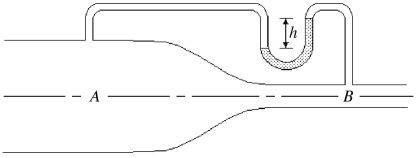Multiple Choice
Bernoulli's principle: Water flows in the horizontal pipe shown in the figure. At A the diameter is 5.00 cm and at B the diameter is 4.00 cm The fluid in the manometer is mercury, which has a density of 13,600 kg/m3. The manometer reading h is 4.40 cm. We can treat water as an ideal fluid having a density of 1000 kg/m3. What volume of water is flowing through the pipe per second? 
A) 0.0206  /s
/s
B) 0.0426  /s
/s
C) 0.00560  /s
/s
D) 0.372  /s
/s
E) 0.186  /s
/s
Correct Answer:

Verified
Correct Answer:
Verified
Q2: Viscosity: Glycerin, with a viscosity of 1.50
Q3: Pressure: One of the dangers of tornados
Q4: Pressure in a fluid: In the figure,
Q5: Viscosity: Suppose that the build-up of fatty
Q6: Bernoulli's principle: You are driving a late
Q7: Density: What is the radius of a
Q8: Buoyancy: A cup of water containing an
Q9: Density: A sphere is constructed of two
Q10: Buoyancy: A barge is 15.0 m wide
Q11: Pressure in a fluid: On planet X,